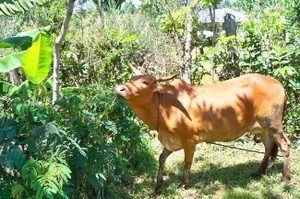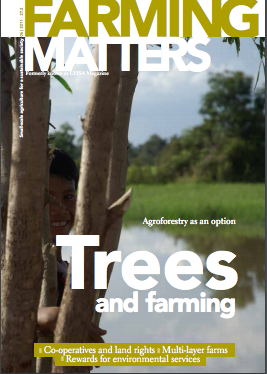Small, fast-growing nitrogen-fixing trees like Calliandra calothyrsus are becoming increasingly popular in the eastern and central African highlands for various reasons: they can provide a yearround supply of protein-rich feed, improve soil and water conservation, and provide mulch, fuel, stalks, poles, nectar and fences. Yet if farmers follow many of the guidelines that are available, they find it difficult to establish enough of them on their farms without external support. Focusing on sustainable and affordable methods, research is providing effective alternatives.

The establishment costs and access to seeds of these highly needed leguminous trees have been found to be the main challenge in many countries. Low, late and unpredictable germination rates make it unreliable to seed plants directly in fields using the methods that are generally recommended. These can even cause low germination rates in nurseries. The seedlings need to grow big enough to survive the dry season (especially on infertile or eroded soils) and to compete with weeds. Common direct seeding methods usually lead to a maximum survival rate of only 15 percent. While many farmers have recently established calliandra trees on their farms, many more would do so if it was easier.
The green, hilly, humid and sub-humid areas to the north west of the town of Kisumu and Lake Victoria, in western Kenya, exhibit many of the common difficulties facing farmers wishing to have calliandra (and sometimes other tree-legumes) on their farms. They see it as a way of being able to support (more) livestock. Fifteen years ago when I was in this area I started a research process, building on my previous experience in Rwanda, Kenya and Ghana, and this process has continued since, on an informal basis. My main interest was to find out how to make it easier to establish calliandra. Several farmers have participated in this project in different ways.
Nearly all the farmers asked expressed their interest in calliandra, but only if it could be seeded easily, and they were not willing to invest much work or money. Soils in this area are usually nitrogen and/or phosphate deficient, and manure and fertilizer often benefit the weeds more than the tree seedlings. So we first tried different direct seeding based experiments in the unfenced fields of ten farmers, looking for ways to increase the germination and survival rates. At the same time, I started several controlled, replicated experiments in fenced fields rented from farmers in adjacent areas (Maseno and South Kaponja). Briefly, our experiments on germination showed that:
- Using a sandal with a flat rubber sole to scratch the seeds against a coarse cement floor or rough grinding stone (just enough to perforate the shiny seed coat so they take up water immediately after planting) can increase field germination after two weeks by 2-3 times, reaching a total of up to 90 percent. This process is known as mechanical scarification. Other experiments showed that simply soaking untreated, dry, mature seeds in unheated water for 1-3 days alone rarely helped;
- Soaking the scratched seeds about 8 hours in a flat basin with unheated water helps;
- It is better to sow the moist swollen seeds early in the rainy season at a depth of 5 cm or a “half finger”. In case of continuous sunshine right after seeding, this can then help seeds to emerge even if the upper soil layer becomes hot and dry (as this layer can be pushed aside after five days).
Our experiments showed that applying kitchen wood ash (in concentrations of about 1%, as otherwise the roots can suffer) can give excellent results, and so did transferring nitrogen-fixing bacteria directly into the field where these are needed. It is also important that advisers and farmers get a complete insight of what can be modified and what cannot in order to get positive results under different conditions – for example, when using stored dry seeds or when their fields are less fertile.
Farmers showed interest
Ten farmers from a dairy-farmer-group from Ebusakami came to visit the fields where we were completing our field-experiments. Most of them got most of the direct seeded seeds to germinate and survive – even though they started their process rather late in the rainy season. Most distributed seeds to friends and said they wanted to expand this practice.
At the end of the project, we were interested in seeing if farmers would be willing to pay the local cost for seeds if shown how to grow them in their fields. Two hours labour could pay for the 400 or so seeds that they usually wanted and scratching the seeds could be done in ten minutes; in contrast, transplanting bare root seedlings would require investing several days work. All ten farmers asked were willing. We have also freely distributed advice and very small seed samples at a few meetings and events and found this worked well. Many farmers who participated have at least a few trees and are directly seeding more.
Good extension can help to realise a big potential. Some extension organisations in western Kenya and Tanzania were trained in the technique and the brief feedback they provided was very positive. Farmers appreciated the uses to which calliandra could be put. They often found new ones too, and liked the alternatives to frequent low pruning we developed that, for example, allowed good seed and wood formation between crops. Extension and research organisations on several continents have expressed an interest in the results, and several international research papers have been published. These methods can also be adapted to other species and climates.
Developing methods better suited to farmers’ priorities and limitations can open up many new possibilities. The photo shown here is from Ebusakami, where the farmer directly seeded calliandra using the improved methods we developed. Calliandra now provides him with much-appreciated fodder, firewood, soil and water conservation properties, good fences, poles, support for his passion fruits, and the farmer’s own invention: a living cloth drying site. Many of his neighbours have asked him for seeds or picked seedlings.
Text and photo: Torsten Mandal
Torsten Mandal is a Danish agronomist specialised in tropical agroforestry and soil fertility management. He currently works as a freelance consultant, trainer and researcher with various organisations. He was previously attached to the Agroforestry Division of the Kenya Forestry Research Institute.

